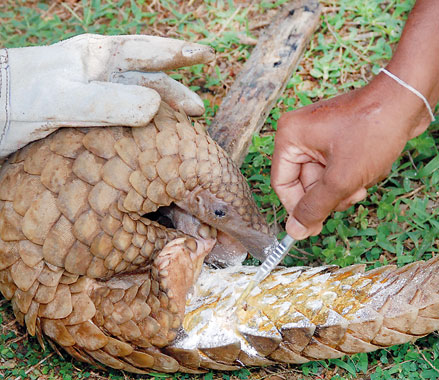News
Pangolins at high risk, warn conservationists
View(s):By Malaka Rodrigo
Conservationists have called for the protection of pangolins, a type of ant-eater known as “kaballawa” or “eya” after it was named the animal at the highest risk in the National Red List of Threatened Fauna and Flora’s “Near-Threatened” category. Pangolins are found throughout Sri Lanka and used to be seen living close to human habitation but poaching and habitat loss has sharply reduced their numbers, said Sampath Goonatilake of the International Union for the Conservation of Nature (IUCN) Sri Lanka.

A wounded pangolin being treated by members of the Galle Conservation Society
The solitary nocturnal animals used to be found in Attidiya and closer to Colombo in the late 1970s and early 1980s but are no longer found there, he said, calling for a thorough study on their numbers to assess their true conservation status.
The pangolin, which is covered with protective scales, uses its very long and sticky tongue to suck out ants and termites from their hiding places. When threatened, it rolls up into a ball to protect itself emits a foul, strong-smelling fluid from its anal scent glands.
Although widely thought to be a reptile, the pangolin is a mammal and is hunted by poachers for its flesh. It often becomes entangled in wire traps set for porcupines and other animals and is also targeted when found emerging from hideouts close to human settlements.
The president of the Wildlife Conservation Society of Galle, Madura de Silva, says the society’s Wild Animal rescue program based at Hiyare, Galle has, over the years, rescued many pangolins caught in traps and given them a new chance of life.
An Indian traveller was nabbed a few months ago trying to smuggle 2.2kg of pangolin scales out of Sri Lanka. The thick, protective scales, made out of kerotene – the same substance as our fingernails – are powdered and used in Chinese medicine.
The wildlife trade monitoring network, TRAFFIC, says pangolins are the most commonly encountered mammals in the illegal wildlife trade in Asia. They are in high demand in east and south-east Asia, with China and Vietnam identified as the largest consumer nations.
The surging demand for pangolins dealt a massive blow to the species in 2011, with 40,000–60,000 slaughtered that year, according to records compiled by the conservation network, Project Pangolin.
Although the pangolin scales trade is well established in the region, the arrest of the Indian traveller marked the first time an attempt to smuggle pangolin scales was reported from Sri Lanka, said Samantha Gunasekara, the head of Sri Lanka Customs’ Biodiversity, Culture and National Heritage Protection Division.

An Indian was nabbed while trying to smuggle out 2.2 kg of pangolin scales out of Sri Lanka
Mr Goonatilake said conservationists had been finding scales of pangolins left around on sites where they had been poached, so he did not believe the trade in scales was currently an organised business. But the killing of pangolins for their flesh was a matter of concern, he said, and a proper conservation program was necessary.
Chinese caught with corals at airport
Three Chinese nationals were caught at the Bandaranaike International Airport at Katunayake last week trying to take out 24 corals. Their illegal booty was detected when Customs officials stopped and searched them as they were leaving the country on March 28.
The corals were wrapped in wet clothes and had been skilfully extracted, without damage to the base. A few oysters were also found.
The Chinese said they were workers at Mattala Rajapaksa International Airport and had collected the corals from the southern coast. They pleaded not knowing that taking corals szx an offence and were allowed to leave for Shanghai with a severe warning.
On March 8, another Chinese man was caught trying to smuggle out about 800 shells and pieces of coral. The Customs Biodiversity Unit said some of the shells belonged to protected species.
Follow @timesonlinelk
comments powered by Disqus















